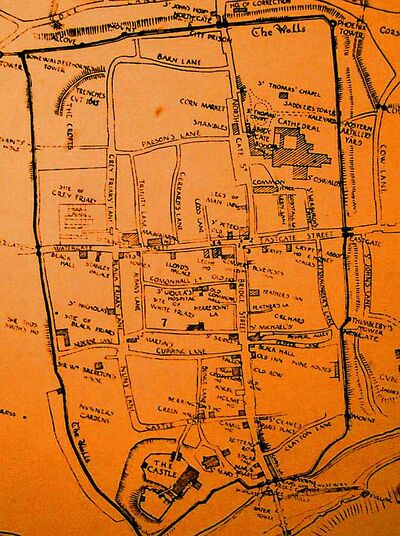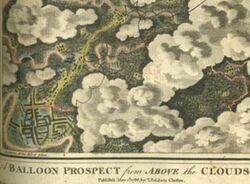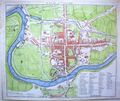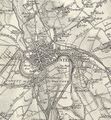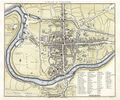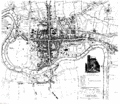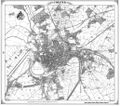Maps
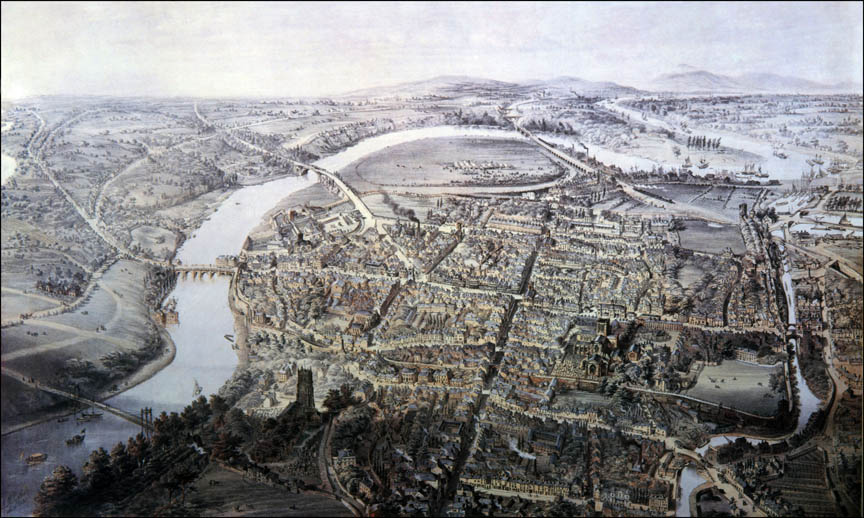
A History of Maps
Old maps are an excellent way to explore the history of a city like Chester, and this article looks at both the history of maps in general and how they relate to Chester. Maps are closely related to "Prospects" and for those there is a separate page: a "Prospect of Chester". The "Maps" category on this site can be accessed at the foot of this page and has links to individual maps of Chester from various periods. This article is about the development of mapping and some of the interesting characters involved in it, many of whom seem to have ended up in gaol at some point.
Who knows who made the first map? The definition is not of itself very precise and there are several candidates for what might be considered the earliest examples of cartography. Undoubtedly, there were others of the "draw it with a stick on the ground" variety that did not survive. Maps in Ancient Babylonia were made by using accurate surveying techniques. For example, a 7.6 by 6.8 cm clay tablet found in 1930 at Ga-Sur, near contemporary Kirkuk, shows a map of a river valley between two hills. Cuneiform inscriptions label the features on the map, and include much information that would not be out of place on later Tithe Maps: a plot of land is described as 354 iku (12 hectares) and it was recorded that was owned by a person called Azala. Most scholars date the tablet to the 25th to 24th century BC. Hills are shown by overlapping semicircles, rivers by lines, and cities by circles. The map also is marked to show the cardinal directions.
The baked clay tablet has a major advantage over later maps: it is far more durable. Many of the documents that "survive" from antiquity do so only in the form of hand-made copies of copies of the text, by medieval monks and otherwise. The "originals" are generally lost. This copying sometimes introduced errors (or purposeful revisions) but copying graphical content, such as maps, was far more likely to introduce variations from the originals.
The earliest ancient Greek who is said to have constructed a map of the world is Anaximander of Miletus (c. 611–546 BC), pupil of Thales. He believed that the Earth was a cylindrical form, a stone pillar suspended in space. The inhabited part of his world was circular, disk-shaped, and presumably located on the upper surface of the cylinder. Little is known about the map, which has not survived. Hekatæus of Miletus (550–475 BC) produced another map fifty years later that he claimed was an improved version of the map of his illustrious predecessor. Hecatæus's map apparently described the Earth as disk with an encircling Ocean, and with Greece placed in the center. As units of measurements, this map used "days of sailing" on the sea and "days of marching" on dry land.
Mapping Britain
Herodotus (c.484 – c.425 BC) possibly drew actual maps, although none survive. As with many of the "famous" map-makers of antiquity he was reliant on traveller's tales. Some of these may have included tales of distant islands on the very edge of the world now known as the British Isles, which were a known source of tin. Herodutus had only vaguely heard of the "Cassiterides" and writes:
- "I do not know of any Islands called the Cassiterides" (III, chapter 115).
Later writers — Posidonius, Diodorus Siculus, Strabo and others — call them smallish islands off ("some way off," Strabo says) the northwest coast of the Iberian Peninsula, which contained tin mines or, according to Strabo, tin and lead mines. Later cartographers would later reconstruct "maps" based on these written descriptions, many of which are very conjectural. As these contain only the most general reference to the British Isles they cannot really be considered as referring to Chester.
The next landmark for maps in any way associated with Chester is the work of Ptolemy which dates from (c.100 – c.170). At the time that Ptolemy was writing Roman Chester had already been established and indeed Legio XX had already (early AD 90's) moved here replacing Legio II. The Romans would have been familiar with the geography of the Irish Sea given the campaigns of Agricola in the years 78-84 (see: Roman Ireland), when Chester was used as a base for supply by ship along the Irish Sea coast. In AD 122 construction of Hadrian's Wall started and Legio XX (or at least significant parts of it) moved north.

Ptolemy is often said to have produced a map of Britain. That is not quite true: in Chapter 2 of his "Geography" he gave lists of the prominent coastal landmarks, river mouths and estuaries, as well as the names of the British tribes and their principal towns. This data included his equivalents to latitudes and longitudes, so it is possible to plot a map using it by placing the dots on a grid and joining the "coastal" ones. There is no definite evidence that Ptolemy constructed any maps or had maps made from his Geography, and not all later editions of the Geography included maps. This was of course before the invention of printing and Ptolemy may have considered that hand copying of his work would distort his maps. He therefore chose to rely on tables of the maximum day length (which increases northwards, i.e. in higher latitudes) and estimates of longitude.
The Roman propensity for building straight roads and numerous well-spaced camps and forts suggests that they had a good knowledge of surveying and implies that they would have used cartography. Roman surveyors were known as Gromatici. Roman surveying instruments included the Groma, an arrangement of supports and plumb-lines with which sightings could be taken and the Dioptra which was a basic theodolite. However nothing really survives of Roman maps relating to the area around Chester.
Ptolemy was based in Alexandria and little of the detailed topography that the Romans actually knew of as regards the north-west of England seems to have reached him. He was also writing about the "big picture" and so it is perhaps hazardous to try to apply information drawn from him at a local scale.
Mapping Cheshire
The process of "joining up the dots" from Ptolemy has been used to produce many maps of the supposed coastline near Chester over the years. Often these can be seen to be influenced by later knowledge of the details of the coatline. These reconstructed maps led to much speculation in Victorian times as to the actual shape of the coastline in Roman times and to the identity of some of the landmarks mentioned. For further information on this see the page on Backford. One example of the speculation is whether the mouth of the River Mersey existed in Roman times. Of the estuaries of the Dee, Mersey and Ribble, only two are shown on maps reconstructed from Ptolemy and some, notably William Ashton, argued that the mouth of the Mersey did not exist (see again: Backford). An alternative explanation (among several) is that Ptolemy does not include all geographical features and that he got his information from sailors who preferred not to sail into the sandbanks near the mouth of the Mersey but navigate between the north Welsh coast and the Lancashire coast.
Another "join the dots" method of mapping the region in Roman times is to use the local "itinerarium" (plural: itineraria). These were an ancient Roman travel guide in the form of a listing of cities, villages (vici) and other "safe" stops on the way, including the distances between each stop and the next. At their most basic, itineraria involve the transposition of information given on milestones, which were an integral feature of the major Roman roads, to a written script.
As an illustration, one local issue with the use of itineraria to map Roman Cheshire is the location of Roman "Bovium". Bovium is the name of a place in Roman Britain which is known only from an entry in the Antonine Itinery. It's inclusion would suggest that the location had to provide facilities for changing relays of horses used for the carriages and gigs of official couriers, and for the storage of government goods in transit.
Bovium is among several places in the Antonine Itinerary which still lack positive identification. It is described (in Iter II) as being 10 miles from Deva (Roman Chester) and 20 miles from Mediolanum (Whitchurch) - i.e. twice as far from Whitchurch as from Chester - somewhere along a line from Tarporley to Gresford, depending on the length of a Roman Mile. The Roman mile (mille passus, lit. "thousand-pace") consisted of a thousand paces of two steps each. It is believed to be about 0.92 modern statute miles, which leads to the difficulty that 30 Roman miles would be 27 statute miles and it is only about 18 miles (as the crow flies) from Chester to Whitchurch. Either this means that "10" and "20" miles are broad estimates, and/or that Bovium was not on a direct line from Chester to Whitchurch. As one writer noted:
- "The problem has formed the centre of a number of discussions, which need not be considered here. Like others of its kind, it has produced theories in which the few available facts have been treated with the usual excess of imagination, if not with complete disregard. The roads themselves are still incompletely known; the exact character of few, if any, of the sites along them has been determined by excavation, and their existence is only known by the quite uncertain evidence of chance finds of pottery, coins, and the like." - Grimes, THE MAGAZ1NE OF THE HONOÜEABLE SOCIETY OF CYMMRODORION VOL. XLI., (1930).
There have been several contenders proposed as the location of Bovium. These range from Bangor-on-Dee to Heronbridge and include Aldford.
Medieval Maps
Many historians believe that the first English map of Britain was produced by Matthew Paris (1200 – 1259) had appeared in about 1250. Paris was not just a scribe; he was also an artist, and, towards the end of his life he turned his hand to mapmaking. Matthew Paris drew a number of unique maps. He drew innovative itinerary strip maps that guided the reader from London to Rome. He also drew the first regional maps of Britain, made even more notable for his decision to orient them with north at the top, in an age when most maps placed north eastward.
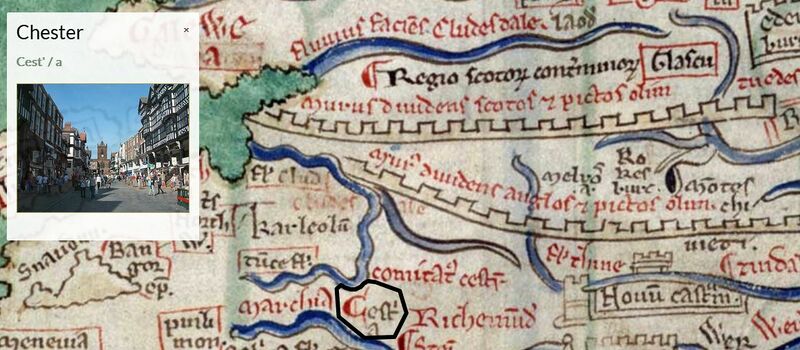
Matthew Paris’s most famous map of Britain, the so-called Claudius map (BL MS Claudius D.vi f.12v) is a complex document filled with regions, cities, monasteries, and castles. While not especially geographically accurate, the map nonetheless presents a unique cartographic perspective on medieval England, Scotland, and Wales. Marked on his map are the River Dee, Cheshire as "comitat ceftr" and Chester itself as "Cest'/a". One way in which the map is not the most accurate in that it omits everything between the River Dee, which he confuses with the Clwyd, and Hadrian's Wall. A digital "point and click" version can be found here and allows all the features to be identified.
There are several versions of a map associated with Higden's Polychronicon. Although he was writing in Chester Higden does not seem to pay any attention to the location of Chester on his map. The map sometimes known as the "Higden Map" or the "Polychronicon Map" does not actually appear to be the work of Higden but a special map prepared for a copy of the Polychronicon and is more properly known as the "Ramsey Abbey map". While the Ramsey Abbey map graphically places England on the edge of the world, Higden does the same in his prose and calls attention to it's isolation. He refers to England as “alter orbis” [another world] twice in the opening to the book, even claiming that:
- “Ora Gallici littoris finis foret orbis, nisi Britannia insula nomen pene alterius orbis mereretur” (the border of the French seaside should be the end of the world, if the island of Britain does not nearly merit the name of another world)

One if the first recognisable maps to show Cheshire in a recognizable context is the so-called Gough Map. The Gough Map of Britain is one of the earliest maps to show Britain in a geographically-recognizable form. The map is named after one of its former antiquarian owners, Richard Gough (1735-1809) who bequeathed the map to the Bodleian Library in 1809. He had obtained it from the estate of the antiquarian Thomas "Honest Tom" Martin in 1774.
The text on the Gough map is the work of at least two scribes: the original 14th-century scribe and a 15th-century reviser. Some of the map’s writing dates it to around the 1370s, placing it in the latter part of King Edward III’s reign, before his death in 1377, or possibly in the reign of Richaard II. However, there is also evidence of later over-writing of some of the map’s place-names which demonstrates a continued interest in and use of the Gough Map into the first thirty years of the fifteenth century. Chester is shown as a large city compared with others, being portrayed as having City Walls and a church with a tall spire - possibly St Peter - the present church dates from the 14th, 15th and 16th centuries, with modifications in the following three centuries. Formerly the tower of St Peter's had a steeple which was removed and rebuilt in the 16th century, taken down in the 17th century, then rebuilt and finally removed "having been much injured by lightning" about 1780. Alternatively, the steeple may just be symbolic.
The map is oriented with north to the left and east at the top, unlike modern maps (as noted above, this was typical of maps at the time). The part reproduced above shows Wales, with Chester in the center of the upper left quadrant. The River Dee can be seen, as can the road from Chester to Shrewsbury. There has been no authoritative date for the map's production.
Thomas Martin believed that the map dated from the reign of Edward III, while 19th-century scholarship suggested a date of c. 1300, during the reign of Edward I. More recently, the map was believed to have been made within an eleven-year window, based on historical changes of place names and sizes. The earliest given date is deduced by the depiction of a city wall around Coventry, which was first constructed in 1355. The latter date is usually given as 1366, the year in which the town marked on the map as Sheppey was renamed Queenborough. Most recent studies, based on handwriting and stylistic evidence, support a later period of production. One study concludes that the map must have been made in the early years of the fifteenth century, while another suggests that the map was produced in the 1370s but extensively revised, perhaps as late as 1430. It is thought possible that the surviving copy of the map may have been based on an earlier document. In particular, it has been argued that some of the information on the map reflects the interests of Edward I, dating the prototype to around 1280.
Printed Maps
It was not until the mid fifteenth century that the principles of mapping were again fully understood. The craft of cartography was boosted by the Italian invention of printing maps from copper plates in 1473, while advances in scientific learning helped the Dutch and Flemish to become the masters of map making by the late 1500s. Maps now became far more reliable.
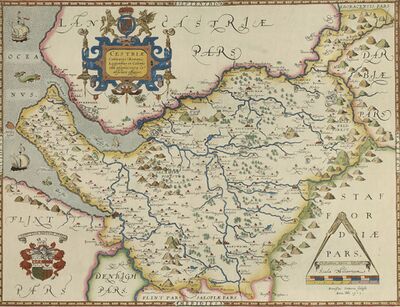
The 16th century saw huge advances in mapmaking. It was a perfect confluence of the new mathematical and surveying techniques rediscovered during the Renaissance, mixed with the printing press that made maps more accurate, popular and useful. In the late 1530’s Henry VIII began a mapping project in England, in part thanks to the Dissolution of the Monasteries, and all the monastic lands that needed to be valued and sold. Elizabeth’s right hand man, William Cecil, wanted to continue that work, and in the 1570’s he found Christopher Saxton, from Osset in Yorkshire, sometimes called the Father of English Cartography.
Saxton's Map
Little is known about Saxton's personal life. It is likely that Saxton was apprenticed in cartographic draughtsmanship and surveying to John Rudd, Vicar of Dewsbury (1554-1570) and Rector of Thornhill (1558-1570/78). During the Reformation, Rudd initially adopted a stridently catholic position, being briefly imprisoned on the orders of Thomas Cromwell. While imprisoned, Rudd would create his first map, a now lost "Ptolemaic" map of the Holy Land, at some point before 1534. This maps was sent, in exchange for extraditing his release from solitary conferment, to the new Bishop-elect of Chester Rowland Lee. Rudd developed a passion for maps, and was engaged at some time in the 1550s in making a 'platt' of England; in 1561 he was granted leave from his duties to travel further to map the country. It is suggested that Saxton accompanied him on these travels, at which time he would have been about 17 years old. Saxton was definitely employed by Rudd by 1570.
Surveying the country was a significant undertaking but the first plates were engraved by 1574 and in 1578 the survey was complete. As the task was finished in a short time-span it is possible that Saxton used some of John Rudd's earlier work. Some adjacent counties were grouped together on single map sheets, but Cheshire and Derbyshire were each given their own single sheet. Saxton used triangulation, viewing the country from elevated positions (such as church towers, monasteries and castles) and taking bearings from several viewpoints. He used local assistance to identify which places could be seen. Saxton's maps were produced in the Atlas of the Counties of England and Wales published in 1579. It contained 35 maps, each bearing the arms of Elizabeth I and Thomas Seckford, Saxton's patron. The maps show hills and mountains but do not provide precise information as to their location or altitude. A variety of symbols show buildings and settlements, but not any roads. The atlas was a commercial success, prompting other cartographers including John Speed, John Norton, and Michael Drayton to attempt similar enterprises, adding to and adapting Saxton's work.
The Saxton maps were republished in 1644 during the English Civil War "in twenty sturdy sheets to be folded as a pocket-map .. Useful for all Commanders for the Quartering of Soldiers". Most of the etching was done by Wenceslaus Hollar (who favored the Royalist cause, but still had to make a living). The title page describes it as:
- “The Kingdome of England & Principality of Wales, Exactly described with euery Sheere, & the small townes in euery one of them, in six Mappes. Portable for euery Mans Pocket… [long list of place names omitted here] …Vsefull for all Com[m]anders for Quarteringe of Souldiers, & all sorts of Persons, that would be informed, Where the Armies be; neuer so Commodiously drawne before this.”
Later editions updated the ending for post-war use, making it “Vsefull for all Gentlemen and Travellors and all sorts of Persons that would be Informed of the Distance of Places” instead.
A mapping error which shows the rather odd course of the Gowy and its split into Golborne Brook over which the Whitchurch to Chester road passes may have influenced events in the Civil War (see: Battle of Hoole Heath). The map suggests that anyone advancing towards Chester from Whitchurch would have to cross a major watercouse which roughly equates to the modern day Golborne Brook.
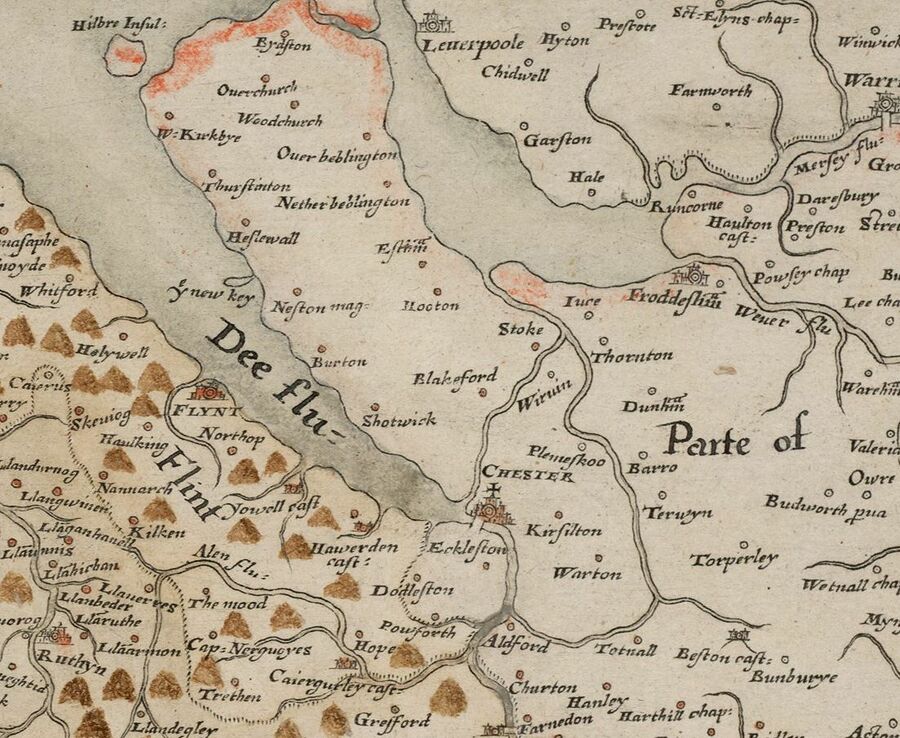
After Christopher Saxton's death (1610), the plates for his atlas of England and Wales were used to publish editions in 1645 (William Web), 1665 (unknown publisher), c1689, and c1693 (Philip Lea). On Philip Lea's death in 1700, his widow, Anne, continued the business. The date of Anne Lea's death is unknown, but on 5 August 1730 the Daily Journal carried an advertisement:
- "To be sold by Auction, On Friday the 14th Instant... All the Copper Plates belonging to the Estate of Mrs Anne Lea, deceased, late of Cheapside... with the County Maps of Great Britain and Ireland, many of them done from an actual Survey thereof...".
The plates were purchased by George Willdey and apparently could still be used to print maps in 1731/2.
The mapping oddity of the Gowy in Saxton's map had been present in earlier written descriptions. Ormerod cites a very peculiar version of the course of the Gowy (taken from Hollinshed) (c. 1525 – before 24 April 1582), with it actually dividing the Wirral from the rest of Cheshire by flowing into both the Dee (as Flookersbrook) and into the Mersey:
- "That, therefore, which they call the Gowy, hath his head not far from Bunbury, and runneth north-west by Beeston Castle, to Teerton and Huxley, where it divideth itself into two parts ; one goeth west to Tattenhall, Gosburn, Lea Hall, and at Aldford falleth into the Dee. The other part goeth northwards to Stapleford, Hocknel-plat, and Barrow (where it taketh in a brook that Cometh from Tarporley and Tarvin), and so passeth to Plemstow-bridge, Trafford, Picton, and Thornton, where it divideth itself again into two parts; one of which keepeth its course north-west to Stanley, Stanney, and Poole, and afterwards falleth into the Marsey. The other part goeth south-west to Stoke, Croughton, Chorlton, the Baits, and so falleth into the Dee, hard by Chester, being there called Flooker's-brook, and divideth Wirral from the rest of Cheshire; and therefore some imagine that it is called Wirral."
Much about Raphael Holinshed (who published in 1577) is obscure. He probably originated in Cheshire, where the surname proliferated, and may have been the son of Ralph Holinshed of Copshurst, a hamlet of Sutton Downes, north-east of Macclesfield. The identification cannot be regarded as certain, however, and the existence of a Raphael Holinshed of Cophurst who was recorded in 1571 in a context far removed from the practice of history would seem to argue against it. The author of the Chronicles may instead have been the Raufe Holinshed named in a heraldic visitation as one of the several sons of John and Katherine Holinshed of Macclesfield.
The idea for Holinshed's Chronicles was born from Reginald Wolfe. A Dutch-born London printer, Wolfe was one of the original members of the Royal Stationers' Company. In 1548, Wolfe conceived the idea of creating a "Universal Cosmography of the whole world, and there with also certain particular histories of every known nation". He wanted the work to be printed in English and he wanted maps and illustrations in the book as well. Wolfe acquired many of John Leland's papers (written 1538-43) and with these he constructed chronologies and drew maps that were up to date. This took over 24 years of his life; however, when Wolfe realised he could not complete this project on his own, he hired Raphael Holinshed and William Harrison to assist him. It is worth noting that "Holinshed" was a collaborative effort, although it is often spoken or written of as if Raphael Holinshed was the only author.
"Holinshed" is clearer that the Gowy creates a freshwater island. He actually writes (in the first book of his Chronicles, Chapter XIV):
- "The Beston water riseth in the wooddie soile betwéene Spruston and Beston castell with a forked head, and leauing Beston towne on the northeast, it goeth to Tarneton, and to Hakesleie, where it diuideth it selfe in such wise, that one branch thereof runneth by Totnall, Goldburne, and Léehall, to Alford, and so into the Dée, the other by Stapleford, Terwine, Barrow, Picton, and Therton, where it brancheth againe, sending foorth one arme by Stanneie poole, and the parke side into Merseie arme, toward the northwest, and another by southwest, which commeth as it were backe againe, by Stoke, Croughton, Backeford, Charleton, Vpton, the Baites, and so vnder a bridge to Chester ward, where it falleth into the Dée arme at Flockes brooke, excluding Wirall on the northwest as an Iland, which lieth out like a leg betwéene the Merseie and the Dée armes, and including and making another fresh Iland within the same, whose limits by northwest are betwéene Thorneton, Chester, & Aldford, on the northeast Thorneton and Hakesleie, and on the southeast Hakesleie and Aldford, whereby the forme thereof dooth in part resemble a triangle."
The wording suggests that this section of Holinshed is taken from Leland (c.1540) who had left behind the utterly disorganised set of notes collected by Wolfe. The "Description of England" portion of Holinshed was mostly written by William Harrison (18 April 1534 – 24 April 1593). In 1559 Harrison was instituted as the rector of Radwinter in Essex, by the appointment of Lord Cobham, who owned the right, and to whom he was also household chaplain. Despite being well known to posterity for his description of England, at this time he had only travelled within a small compass in the south of England. As well as using Leland he gathered his facts from books, letters, maps, and conversations with antiquaries and local historians like his friends John Stow and William Camden.
Morden and Others
Later maps would repeat the cartographic peculiarity of the course of the Gowy in Saxton for the next 200 years, showing that their authors did not always perform a complete new survey. A map of 1608 shows Golborne brook connecting the Gowy and the River Dee. It also shows the Mersey estuary connected directly to the Dee by a watercourse along the Backford Gap. Robert Morden's map from a reprint of William Camden's Britannia (1695) shows the Gowy rising near Peckforton, but then splitting near Huxley to flow over to Aldford and become Aldford Brook (which is quite wrong) and then splitting again at Thornton to flow both into the Dee and the Mersey, which is again quite wrong. There was originaly a stream along part of this route which is now taken by a section of the Chester-Ellesmere Port canal. A reproduction of the original Morden map can be found here.
Both Morden and Saxton appear to have strange ideas about the shape of Hilbre Island which show the main island as the only one present much larger than it actually is. Some have attempted to explain this by erosion rather than inaccurate mapping.
Morden's map shows a few roads (this is explained below), including those leading from Chester as the modern day A51, following the Roman route to a crossing of the Gowy at Stamford Bridge and a pass through the hills near Kelsall leading on to Northwich. It also shows the route through Tarporley to Nantwich and thence eventually to London. For more on these see: Road Transport. The original Roman route towards London, via Aldford, became disused by the later 14th century. Morden's map also shows detail of the position of channels and sandbanks in the coastal rivers. For 200 years after Saxton the addition of roads and the marine features (usually copied from specialist coastal charts) would be the only real "improvement" to maps of Cheshire. As regards being mapped, other counties did considerably better than Cheshire during this period. Maps of Cheshire still had exaggerated "humps" denoting hills or mountains and rather indiscriminately scattered tree symbols representing woodland (save for the parklands where trees were circled by palings in the style of Saxton).
Among the specialist "sea charts" is the 1732 Dee estuary survey of John Mackay showing the proposed course of the "Dee navigation". It is likely that the chart was commissioned by the London Cheesemongers, to accompany The "Case of the Cheesemongers" (see: Cheshire Cheese). This was part of the long-running argument over the "improvement" of the River Dee by canalization of the river in the estuary.
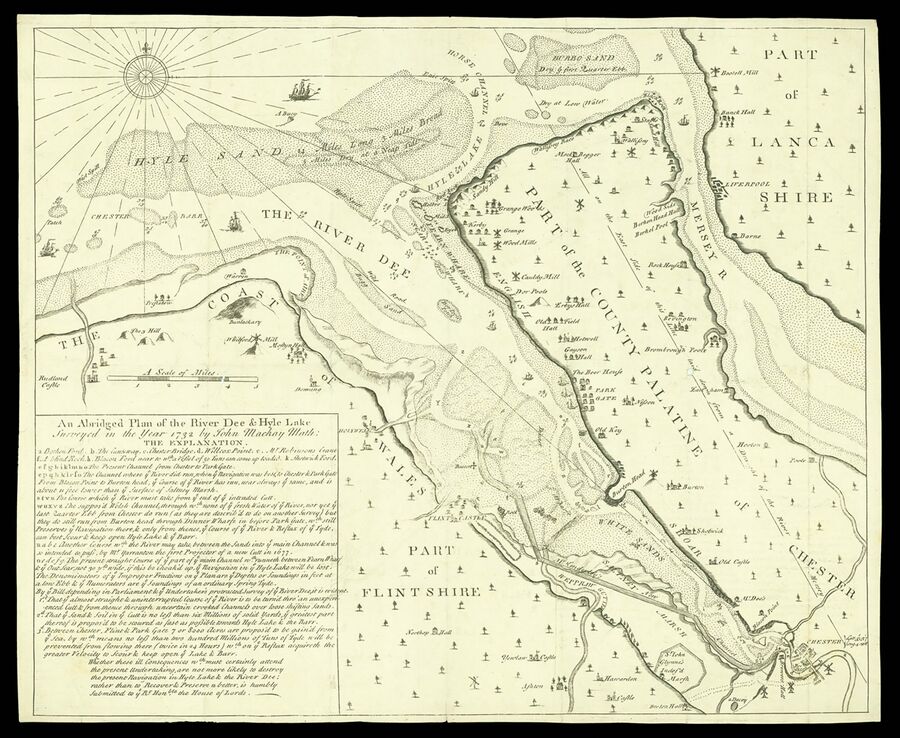
Mackay's map is clearly concerned with water rather than land and concentrates on the positions of sandbanks. The coastal features which are shown are presumably those (such as windmills) which are of some use to navigation on the water or of other use to mariners, such as the "beer house" at Parkgate. Interestingly, Mackay shows what appears to be a watercourse joining the Mersey and the Dee which is possibly that of Saxton, Holinshed and possibly Leland: the last writing almost 200 years before Mackay.
As for the maps of the wider county, one example of such a map is that of Emanuel Bowen (1751). No minor roads are shown and some parts of the county, such as the Wirral Hundred are completely devoid of roads. There are some vague indications of the layout of Chester and the "New Cut" in the River Dee is shown. At this stage the canalisation of the Dee had been partly completed with the first section opening in 1737. It is not clear whether the mythical river connection between the Mersey and the Dee is shown on Bowen's map as this follows the course of the boundary of the Broxton Hundred and by Bowen's time the two may have become somewhat confused.
Ogilby
Skipping back to 1675 an interesting set of "maps" were published by the remarkable John Ogilby (1600-1676), Scotsman, dancing master (until his fall while dancing in a masque in February 1619, aged 18, lamed him for life), Deputy Master of the Revels, publisher, and cartographer, who published his "Britannia" in 1675. This showed all the main routes radiating from London, together with a handful of cross-country routes.
Like the old Automobile Association personalised route-maps, they are strip maps which concentrate on the roads, orienting the traveller with a compass rose, and showing side roads, landmarks, and the type of terrain, hills to be surmounted and rivers to be crossed. The scale was a standard inch-to-a-mile. The maps are very large, 415mm wide x 329mm high, and the pages they are printed on even larger: it is difficult to imagine anyone other than a well-attended gentleman using them in transit. Though not as well known as the maps are, he also provides written information about the distances, terrain, "Backwards turnings to be avoided", the major places of interest, market days, and whether the traveller is likely to find suitable 'entertainment', i.e. hospitality.
Ogilby's road maps were 'improved' by John Owen & Emanuel Bowen, in their Britannia Depicta or Ogilby Improved (1725). They also reduced them to a manageable travelling size: these cropped pages are 137mm wide by 220mm high. Bowen was responsible for engraving the 272 strip maps, and Owen, the antiquarian, the topographical information. They printed the useful information for travellers supplied by Ogilby alongside the maps on the same page, adding further historical notes, coats of arms (to be coloured in), and descriptions of the nobility and gentry associated with the area.

Morden, as mentioned above, appears to have got much of his information from Ogilby as well as earlier maps. These were first published in the 1695 edition of Camden's Britannia by Edmund Gibson. He took them from Ogilby, however, so they only show the main roads from London and the few cross-country roads Ogilby had surveyed. They are portrayed as narrow double lines, and could almost be missed altogether; county boundaries (the heavy dotted lines) are much more prominent. Gibson's preface explains that while the maps by Morden are newly engraved they owe much to the surveying of others:
- "The Maps are all new engrav'd, either according to Surveys never before publish'd, or according to such as have been made and printed since Saxton and Speed."
Given that Ogilby did not include routes through the Wirral, Morden does not include them on his map. Ogilby's maps relating to Chester can be found here and the whole text is available online. Cadell & Davies published its own editions of the Britannia Depicta atlas over many years, with accompanying descriptions by Samuel Lysons. It was billed as a series of 130 views of "the most interesting and picturesque objects in Bedfordshire, Berkshire, Buckinghamshire, Cambridgeshire, Cheshire, Cornwall, Cumberland, & Derbyshire".
Turnpike and Canal
The needs of the Industrial Revolution would change map-making. Not only were surveys needed to plan turnpikes and canals, but some shareholders wanted to see what was being proposed. In the second half of the eighteenth century a fresh generation of county surveyors set about the re-mapping of England. They eschewed the older surveys (for so long plagiarized), worked with new instruments, embraced more accurate systems of survey, standardized the then relatively large one-inch-to-one-mile scale in their maps, and, in so doing, depicted the face of the countryside with an unprecedented wealth of detail.
Despite thia many poor quality maps were still produced, often as copies of other maps. Withe growth of turnpikes, canals and eventually railways these were frequently out of date. In some cases, especially during the "Railway Mania" they showed lines which had not yet been built and in some cases never were built.
Burdett
The Royal Society’s 1759 appeal called for accurate county surveys to be produced at a scale of 1” to the mile. Awards of £100 were granted to a few successful cartographers, one of which was Peter Perez Burdett for his map of Derbyshire (1767). Unable to get the necessary financial backing for a proposed map of Lancashire after his move to Liverpool, Burdett turned to Cheshire, where his early survey work was carried out 1772-4. Burdett was a semi-professional surveyor and also an artist who was well-known to Liverpool society. It was Burdett who founded a Society of Artists in 1769 in Liverpool and became its first president.
The county survey of Peter Burdett, whose map of Cheshire was published in 1777, marked the dawn of the modern period of mapping in the county. Burdett was involved with mappings of "commercial" importance. in 1769 he surveyed a route for the Liverpool promoters of the Leeds and Liverpool canal and in 1771 he surveyed and published a Chart of the Harbour of Liverpool.
Fundamental to this new survey, and underpinning its improved accuracy, was a method of trigonometrical survey employed for the first time in the mapping of Cheshire. Previous surveys had been based either on the rather haphazard fitting of itineraries into a county framework or, at best, on planned road traverses, with the surrounding countryside being angled by the surveying compass from vantage points along the main routes. Burdett founded his maps on a carefully executed trigonometrical framework whose character is demonstrated by the triangulation diagram engraved on his map. For further information on Burdett's maps see the links below.
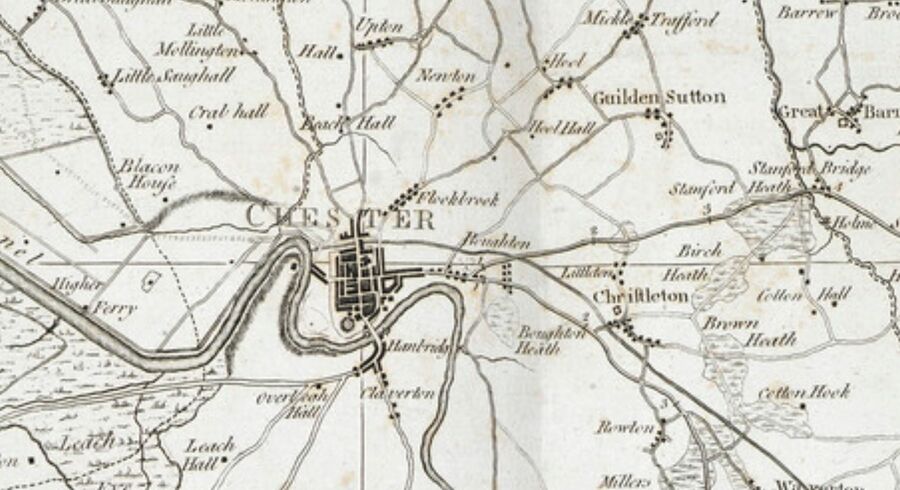
As a historical footnote Burdett may appear as a spectator in the artwork A Philosopher Lecturing on the Orrery by Joseph Wright of Derby. It is now in the Derby Museum and Art Gallery. He also appears in another work by Joseph Wright showing both Burdett (holding a telescope) and his wife Hannah. In 1774 Burdett left Liverpool, to escape debt, and entered the service of Charles Frederick, Grand Duke of Baden. He took with him the double portrait by Joseph Wright of himself and his first wife, leaving her behind to face his debtors. The painting is now in the collection of the National Gallery of Prague. He did not leave his friends entirely and Wright visited him in 1774 in south Germany. He married again to Friederike Kotkowski in Germany on 11 July 1787 and he had a daughter Anna, who went on to marry a count. In the same year he was drawing up plans for Karlsruhe marketplace whose outline can still be seen in the layout of today's buildings. Perez Burdett died in Karlsruhe on 9 September 1793.
Lysons
Daniel Lysons (1762–1834) was an English antiquarian and topographer, who published amongst other works the four-volume Environs of London (1792–96). He collaborated on several works with his antiquarian younger brother Samuel Lysons FSA FRS (1763 – June 1819). Their most relevant book for Cheshire and Chester is Magna Britannia. Unlike other similar works published in the seventeenth and eighteenth centuries, Magna Britannia is of significant value to economists and social historians because the Lysons brothers included content on topics such as population, manufacture and commerce: for example, their map of Chester features the Leadworks.
At the same time that the Lysons were writing there was a great expansion of the number of guidebooks being written on Chester. In 1781 Broster had written the "Chester Guide" and many others would follow (see: Books)
After Burdett
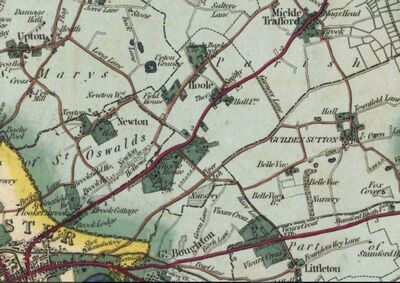
Burdett's map was followed by that of Christopher Greenwood (1819). A Yorkshire surveyor, like Saxton, Greenwood emulated him in trying to produce an atlas of all the counties of England and Wales. He nearly succeeded. Working with his brother John and other partners, first in Yorkshire, then in London, he surveyed 33 English and 4 Welsh counties, most at a scale of 1” to the mile. Unlike Burdett, who had to do all his own surveying, Greenwood had the great advantage of being able to obtain trigonometrical data from the Board of Ordnance. The four sheets of Greenwood’s Cheshire map show more detail than those of Burdett and are noted for the quality of their design and engraving. In 1818 the Greenwood brothers formed a partnership in London with sollicitor George Pringle and surveyor George Kemp. The business was highly productive at first, printing many county surveys, but later fell into financial trouble and closed in 1828. Christopher was imprisoned for debt in 1834 and the brothers' printing plates were sold to pay their debts.
Greenwood was followed by William Swire and W. F. Huchings who published a map in 1830 from a survey made in 1828/9. Andrew Bryant's map of Cheshire was published in 1831. Bryant is another interesting cartographer who, like many of his predecessors seems to have run-up debts (as did his father, who died in jail). The diaries of one of Bryant's surveyors of Cheshire, William Lloyd Holden survive for the years 1829-30. The dairies show that the "actual" surveys of Bryant, the Greenwoods and their contemporaries were primarily exercises in compilation and synthesis from existing large-scale local mapping, supplemented with additional information from personal observation, rather than entirely new surveys. Bryant published a dozen county maps from 1822, before going out of business in 1835 due to the increasing difficulty in competing with the government-supported Ordnance Survey.
The Ordinance Survey
The Ordnance Survey (OS) is now the national mapping agency for Great Britain. The agency's name indicates its original military purpose, which was to map Scotland in the wake of the Jacobite rising of 1745. There was also a more general and nationwide need in light of the potential threat of invasion during the Napoleonic Wars. The origins of the Survey date from c.1747.
The first OS maps seem to have been based on the prime meridian at Greenwich, but this is nowhere near the north/south central line of the British Isles, and therefore could only be used for areas south of the Wash, north of which the meridian ran out to sea. For northern and western Britain a different meridian was needed. Sometime in the 1820’s the "Delamere Meridian" (latitude 53º13’17”274N, longitude 2º41’03”562W) was adopted as the single new meridian. This was on Old Pale Hill (National Grid SJ543696) and was the origin of the first Ordnance Survey one inch mapping of the whole of the United Kingdom. Nearby is a ring of county stones (Derbyshire, Staffordshire, Lancashire, Shropshire, Denbighshire & Flintshire) pointing in their general direction with the large stone in the middle signifying Cheshire. It is an easy walk from the car-park at Gresty's Waste. There are many landmarks to spot on a clear day - Jodrell Bank, Moel Famau, Liverpool and Long Mynd to name but a few. On the outer edge of the circle there are some plaques showing some of these landmarks.
Mapping Chester
The city of Chester is fortunate to have been "mapped" many times during history. To save space we have not included high resolution copies of all the maps here (they tend to be large files). Links are provided to high resolution sources where available (the said links may sometimes be "broken"). One of the early maps is unique in that it is the first image of the ground actually taken from the air, by the balloonist Baldwin in 1785.
For a great tool to compare maps throughout the years, Cheshire Archives and Local Studies has their Cheshire Tithe Maps Online website. This is a comprehensive overview of the Cheshire area with many maps to compare and search.
For a wide selection of relatively modern maps see this collection at the National Library of Scotland. The icon of the walking person on the left leads to an example showing a side by side comparison. Climate maps can be found on the Weather page.
There is also a list of older maps available at the National Library of Scotland.
Maps on this site (or due to be)
Walking around Chester with a modern map, GPS or whatever can be fun, especially if geolocated to sites of historical interest. Even more potential fun (for some) is doing it with an older map or even wuth one of the older Guide Books. For the historian, maps are useful as they show the growth of the city over time and lead to theories about why new development was located where it was: in very general terms perhaps first the development of Handbridge, then outgrowth along the "London Road" to Boughton, the development of the Canal and Boatyard, and with the coming of the railways the expansion of Hoole.
- Braun and Hogenberg - 1581. The first known, detailed map of Chester. This is useful in that it shows many buildings which still exist today (churches, the castle) although much of these have been modified or reconstructed over the years. The City Walls are shown in quite good detail, especially the towers around the walls. Many of the current streets within the walls already exist at this date. The version on this website has been modified with a bit of modern technology so it is "point and click" and would have been a great boon to the Elizabethan tourist if they were armed with mobile phone.
- Smith Map - c.1588. Almost contemporaneous with the above but showing slight differences in the layout of the streets. Details of individual buildings, particularly along The Rows are probably not accurate.
- John Speed - 1610. A few years after the previous two, and by now the Watertower appears to be on dry land, with the course of the River Dee shifting. There appears to be no sign of the Phoenix Tower in this one (was it in ruins at the time?), but the waterworks have appeared at the Bridgegate.
- Hollar's Map - 1660's. The Phoenix Tower is back and the Watertower is definitely out of the water. The waterworks are still in the center of Bridgegate so that dates the map before the destruction of the waterworks tower in the Civil War.
- Hemingways Map - showing the city at the time of the Civil War (1645). However his Bridgegate has the waterworks tower in the position it was rebuilt in somewhat later, now above the western side of the Bridgegate. In details, Hemingway's map is not particularly accurate
- Lavaux Map - just before the Canal (1745). A recognizably more modern style of map, with the new course of the River Dee below Chester quite clear. The Watertower now stands well clear of the River Dee. No canal yet! Lavaux marks many individual buildings as the homes of noted residents, and research has revealed much more about many of these individuals.
- Mutlow and Stockda1es Map - engraved by J.Mutlow, published by John Stockdale in 1795. This shows the original canal, with no Wirral Line branch to Ellesmere Port.
- Coles Map - engraved by John Roper for publication in "The Beauties Of England And Wales", that was published in parts, from c.1804. The Ellesmere Port branch of the canal appears.- there has been much growth without the Watergate and development of the Portpool.
- John Webb Map (1833) - on the eve of the arrival of the railways.
- 1872 OS Map - The Ordnance Survey Map from 1872. Chester before the ring-road, but the Grosvenor Bridge and the railways have arrived. Building outside of the old city area is just starting.
Some other maps of Chester
Peter Burdett's map of 1777 covers all of Cheshire, but the booklet in which it was republished has some interesting details on Chester. These include a plate for overprinting the Burdett map to add some further information including details of Flookersbrook.
OS Maps
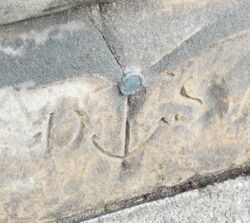
North:
South:
Other Map Stuff on this site
- Millennium festival trail - a guide to historic Chester;
- Roman Festival Trail - just the parts of Roman Chester;
- A Chester Lightning Tour - the main sights, in a day;
Interesting Maps
- Lightning Map of thunderstorms;
- Flood Map - raise and lower the water level;
- - aircraft
- Soviet Era Military Map;
Sources and Links
Related Pages
Online
- Mapping Medieval Chester;
- ChesterWalls.info maps;
- Maps of Chester and Cheshire from "Genmaps";
- Chester Civic Trust's Millennium festival trail has a downloadable map;
- The Buck Brothers prosepect of Chester 1728;
- Burdett's map of Cheshire 1777;
- WILLIAM YATES AND PETER BURDETT: THEIR ROLE IN THE MAPPING OF LANCASHIRE AND CHESHIRE DURING THE LATE EIGHTEENTH CENTURY;
- Walls Heritage Trail downloadable pdf;
- Maps of Chester at Vision Of Britain (good if you like maps);
- More maps of Chester;
- even more.... - most impressive!;
- The Gough Map;
- Roman Roads of Britain;
- Cartography Unchained: was Chester a key reference point on early maps?
- Maps in the Service of the State: Roman Cartography to the End of the Augustan Era;
- Cheshire Local History Society: maps page;
A gallery of Old Maps of Chester
Braun and Hogenberg (1581)
Smith Map (c.1588)
John Speed (c.1610)
Hollar's Map (1660's)
Lavaux Map (1745)
Hunter Map (1789)
Mutlow and StockdaIes Map (1795)
Coles Map (c.1804)
John Webb Map (1833)
Hugh Roberts (1858)
